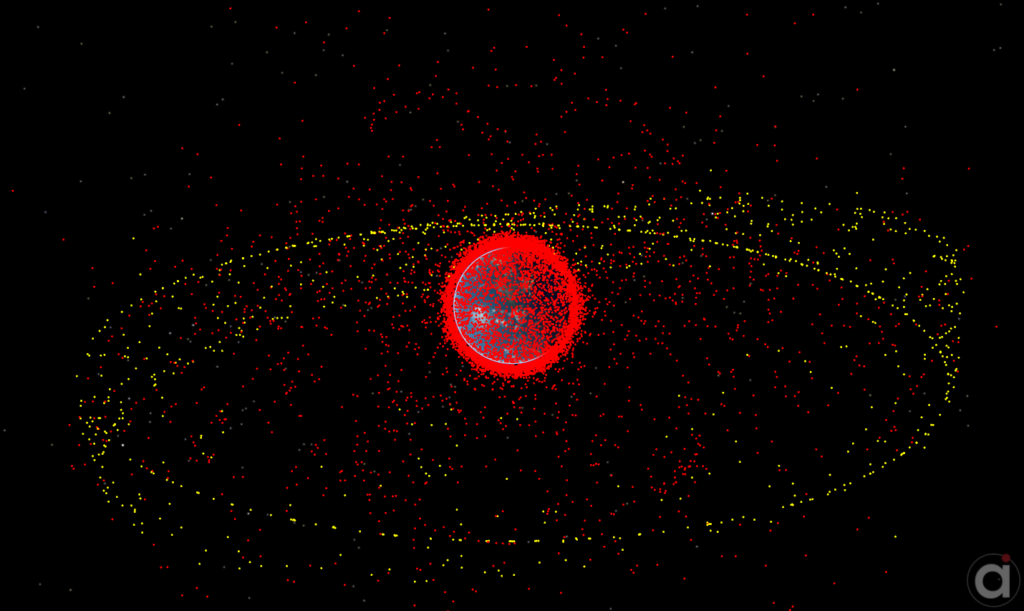
Automated
The Joint Space Operations Center (JSpOC) tracks roughly 22,000 objects orbiting in near-Earth space, including more than 1,200 operational satellites and thousands of pieces of space debris. The JSpOC catalogs and screens these objects for possible collisions with one another, but what about potential collision issues beyond near-Earth orbits? That is where expanded space situational awareness (SSA) comes into play. As we move beyond low-Earth orbit (LEO) and the International Space Station (ISS), SSA remains imperative to the safety and operational success of future deep space missions.
 FreeFlyer® Simulation of the publicly available space catalog (source: space-track.org)
FreeFlyer® Simulation of the publicly available space catalog (source: space-track.org)
Evolution of Technology
SSA technology for near-Earth observation is constantly advancing. But, cis-lunar and deep space exploration (which includes the geostationary belt and beyond) is on the horizon in the not-so-distant future. It is vital to improve and evolve current SSA capabilities and technology used to monitor Earth’s orbital population, the space environment and possible threats, and begin adapting them to these more long-term space exploration goals. Specifically, continued advancements need to be made in several key areas:
Natural Occurring Objects
Naturally occurring objects in space refers to items such as asteroids, meteoroids, celestial bodies, etc. Identifying and tracking objects smaller than the ISS becomes more difficult as we move past LEO. Without keeping an eye on them, such objects could severely harm spacecraft and the integrity of future deep-space missions. This is the primary area where advancements in SSA technology are most needed to ensure future missions are successful.
Space Surveillance and Tracking (SST) Systems
SST systems detect and predict the movement of the thousands of pieces of space debris currently in LEO. This includes any space object or hardware fragment that no longer serves a useful function. SST data can be used to defend space-based infrastructure – such as satellites and navigation systems – from collisions with debris. But, tracking items and debris with traditional SST methods becomes more of a challenge as man moves deeper into space. Features such as on-board orbit determination and correlation software – like what will be operational on the James Webb Space Telescope – become critical for future deep space missions.
In addition, the total number of trackable objects in space is expected to grow exponentially in the next few decades. Computers will have to process millions of objects at one time, which ultimately impacts the design of an SST system. a.i. solutions’ work with Graphics Processing Unit (GPU) technology, can parallelize spacecraft propagation for millions of objections simultaneously and perform “all-versus-all” conjunction screening for the entire space catalog every second. NASA successfully used GPU technology on its Magnetospheric Multiscale Mission, which resulted in a 1,000-fold performance increase over traditional CPU computing methods, as well as substantial hardware and personnel cost savings for NASA.
Deep Space Imaging (DSI)
There is an immense lack of imaging capability in deep space. Without the ability to capture images of objects and their proximity to critical assets, the danger of potential collisions skyrockets. This is a technology gap, however there are those in the commercial space industry that are working to address this issue. Revolutionary science and technologies must be infused into current SSA practices to take DSI to the levels needed for spacefaring nations.
Space Weather Effects (SWE)
We don’t have a clear understanding on how to predict extreme space weather conditions – such as solar wind, radio bursts, X-ray flares, high-energy solar particles, radiation and more – that could affect deep space missions. Continually advancing technology based on data captured from extreme space weather events will help prevent damages that could occur in systems such as command and control units or solar array panels.
a.i. solutions’ Role with SSA
At a.i. solutions, our work is rooted in finding a solution to furthering space exploration on a more expanded level. For more than 20 years, we have designed, analyzed and operated space missions of all sizes. Our flight dynamics engineers and software developers have created robust solutions to address a myriad of mission-based challenges, including SSA.
Our SSA work centers around our FreeFlyer® COTS flight dynamics software, which contains the core flight dynamics algorithms for the modeling and simulation of any CA/SSA event. In 2003, NASA’s Goddard Space Flight Center (GSFC) performed its first collision avoidance maneuver for the Aura spacecraft based on our analysis performed in FreeFlyer.
 Artist’s rendering of the Aura spacecraft. Copyright: NASA
Artist’s rendering of the Aura spacecraft. Copyright: NASA
We later developed the Conjunction Assessment Risk Analysis (CARA) program to expand capabilities to all operational missions flown from GSFC. The CARA program went live in 2005 and now provides automated ingestion of JSpOC Orbital Conjunction Messages (OCMs) into a robust system using FreeFlyer and MATLAB. To date, CARA has supported 65 spacecraft, ingested more than 1.2 million JSpOC OCMs for further analysis and performed 141 risk mitigation maneuvers.
Since then, FreeFlyer has been used to support more than 200 space missions to date. Its flexibility model any mission, including SSA-centric ones, is evidenced by its usage on numerous other government programs, including the Mission Control Center and Magnetospheric Multiscale Mission programs (for NASA) and the JSpOC Mission System program (for the U.S. Air Force). In addition, we provide all operational flight dynamics capabilities on two critical Air Force SSA missions: Space Based Space Surveillance and Geosynchronous Space Situational Awareness Program.
 FreeFlyer® animation of Space Situational Awareness Modeling
FreeFlyer® animation of Space Situational Awareness Modeling
We are constantly working with our industry and government partners to identify ways to extend SSA capabilities into deep space. While there isn’t a current solution in place, industry recognizes the importance of finding one soon so we can safely continue the quest to explore some of the farthest destinations ever imagined. To learn more about our work with SSA or to get information about our products and services, please contact us here.


